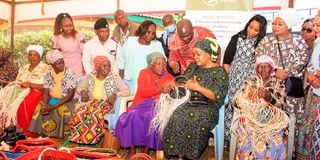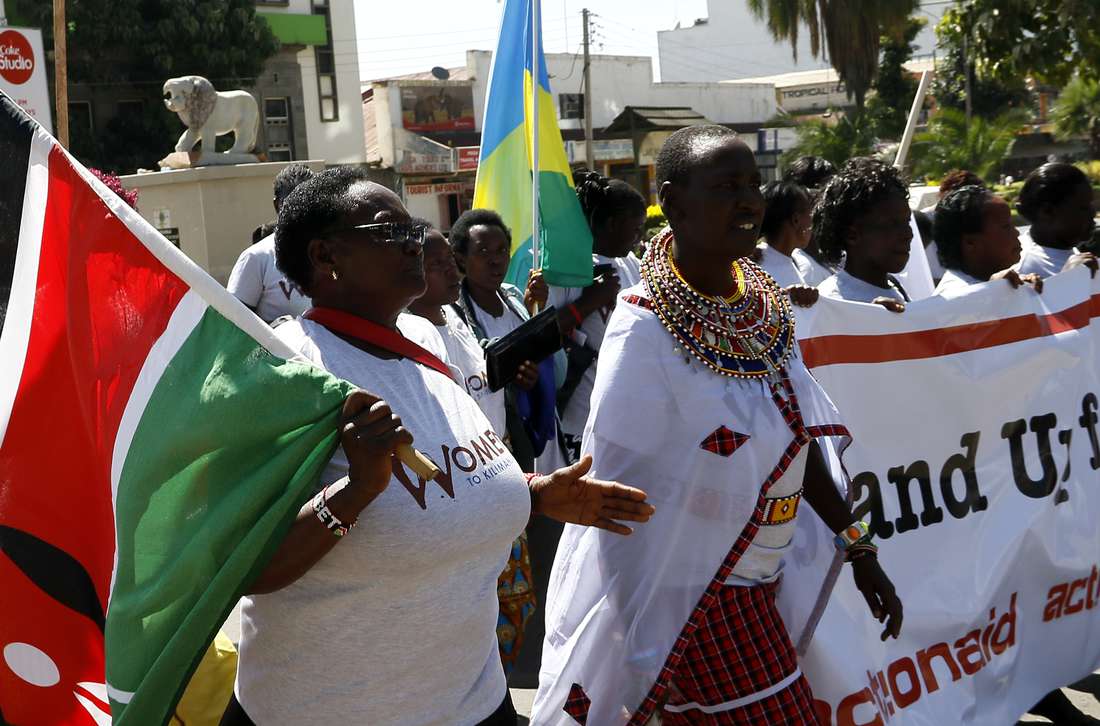Come up with safety nets for widows’ welfare

Tessie Musalia (centre) watches as Beatrice Wambui, 73, weaves a basket at Muthithi location, Kigumo constituency, Muranga County during the Ushiriki Wema initiative that aims to empower widows and the elderly. Looking on is Ahadi Kenya Trust CEO Stanley Kamau.
Photo|
According to the 2022 Kenya Demographic and Health Survey (KDHS), widowed women were 7-12 times more afflicted by disability than any other group of women in the country.
The Ministry of Health defines disability as any physical, mental, intellectual or sensory impairment that interacts with environmental barriers to hinder full and effective participation in society.
Based on the 2019 population census, an estimated 900,000 Kenyans live with disability. And 12.1 per cent of the widowed women were functionally disabled compared to one per cent of never-married women, 1.2 per cent of married women and 1.6 per cent of those divorced and separated.
Physical disabilities affect the ability to walk, feed oneself, bathe and dress. Other disability domains include visual impairment, hearing, speech and language disabilities, mental health disorders, intellectual disabilities, and autism spectrum disorders.
In the 2022 KDHS, 42.8 per cent of widows had visual impairments, 45.9 per cent had mobility problems, 27.6 per cent had memory problems, 19.8 per cent had hearing problems and 17.9 per cent had self-care challenges.
The high incidence of disability among widows can be linked to such factors as ageing and chronic illnesses. Widows are on average older than married, divorced, separated or never-married women.
Many encounter disability as they age, a fact that is aggravated by poverty and chronic illnesses. They are among the poorest due to the loss of a breadwinner, property disinheritance, home eviction, unemployment and stigmatisation of their micro-businesses.
Chronic stress
As a result, many widows don’t have health insurance. Poverty in widow-led households increases food and nutrition insecurity. Exposure to chronic stress increases inflammation in their bodies, leading to illnesses such as hypertension and diabetes. The KDHS data also shows that widows experience twice as much sexual violence as married women.
The effects of disability in widowhood are monumental for the widow, her children, her community, and our country at large. Most cannot work or be employed and are viewed as an economic burden.
Mobility and self-care problems reduce personal autonomy and heighten isolation, depression and suicidal ideation. Disability among widows exposes their children to greater risks of remaining trapped in the cycle of poverty, with difficulties accessing basic needs including education. Disability robs our communities the care, wisdom and talents of the widows and their affected children.
The government gives the elderly and the severely disabled a Sh2000 monthly cash transfer. We need policies that will protect the health and well-being of widows. The government should also make the National Health Insurance Fund scheme more accessible to them. Every Kenyan knows a widow. We should treat them with dignity because they are part of us.
Ms Odhiambo is the Founder and Executive Director at Nyanam Widows Rising and a PhD student at Maseno University.




